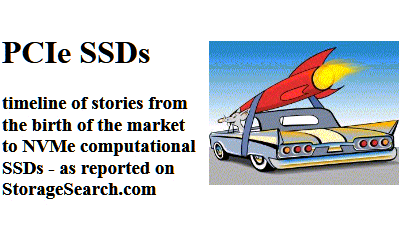|
by Zsolt Kerekes,
editor - StorageSearch.com
- September 11, 2012 |
Sometimes putting a name to something
helps you deal with it.
Because even if you don't understand the
underlying details a useful coping strategy is to place the word or phrase
in your mental map of what's going on.
Later - if the new concept
becomes a bigger part of what you need to know on a daily basis you can read
up some more about it. But having a label gives you an initial hook to hang
your thoughts on. You could say that's the typical life-cycle of most
SSD jargon.
Have
you been wondering about the viability of vendor business models in the
enterprise SSD market
lately?
My guess is that then even if you're comfortably familiar
with the core
user value propositions for SSDs and on passing terms with
various key
enterprise flash technologies - and even if you're already well versed in
the arcanarie of the enterprise datacenter - then I think you'll agree with
me that a lot of what's happening in enterprise SSD land still doesn't
appear to make sense.
For example:-
How do all these market
size projections add up?
And why are
VCs cheerfully tossing
nearly as much new money into the SSD pot as the whole pot was worth in
revenue not that long ago?
I've written before about
some of the more obvious
reasons that enterprise SSD revenue is accelerating - which can be summed
up as saying this.
There was a time when most apps didn't depend on
SSDs. When users try out SSDs for the first time they're cautious at first -
but if they get good results they know a whole bunch of other places they can
also use SSDs in the future - and each time - as using SSDs gets more familiar
- the next purchase is bigger and happens quicker. This transition phase from a
"new" technology becoming mainstream is what creates a "growth bubble" for
vendors.
Fair enough - but how big will the eventual SSD bubble be?
My
long held view
is that all the traditional ways of
prediction can't
help but understate
the destination size of the SSD market.
That's because SSD is a
disruptive market and doesn't only replace old ways of doing things - but will
create new markets that didn't exist before and which couldn't have existed
before SSDs reached a threshold level of awareness and affordability.
What
are the new SSD empowered apps?
And who will be the biggest future
users of enterprise SSDs?
That's a subject which I discuss a lot with
vendors. It's fun guessing - and
some
of the guesses may be right. But just as it would have been impossible to
predict with detail the effects of the
microprocessor and
the internet when those technologies started to become well known - it's
probably impossible to predict with any level of precision what the SSD
empowered super new markets of the future will be.
I call
this market factor - "SSD Dark Matter"
Like cosmological
dark matter - the SSD dark matter will be bigger in mass than anything which we
can currently see or foresee.
I often say to enterprise SSD marketers
- it's easy to create a list of the top 10 oems or user sites which already use
SSDs - but no one's got more than a small fraction of the list of future
SSD user heavyweights - because they don't exist yet - or if they do - they're
in stealth mode.
They can see us - however - and if you're looking in
today - then Hi!
The SSD Dark Matter Market is one of the
reasons I urge all SSD companies to put more info about what they do on the
visible web.
Be clearer explaining what you do.
Don't hide
silly obvious stuff behind log-ins and NDAs.
And improve your
online
signposting. You're just one among hundreds of SSD companies - so to make
it easier for the dark matter people to find you.
The new startups
don't have the time or patience to follow your tangled old marketing
communication threads.
They're not going to tramp around booths at a
conference to swap business cards and war stories about the
good old days of
storage and servers.
Today, tomorrow and the next unknowable 5 years are the good old
days for them.
But here's the good part. And you can do something about it.
If the dark matter SSD people like your SSD technology and place it at the
heart of their own launch platforms - they could make you seriously rich.
The SSD Dark Matter impact is why the SSD market will grow to be many
times bigger than anyone with a sane spreadsheet could possibly expect.
Later:-
at the time of writing this blog I was thinking of the web scale companies, the
cloud infrastructuralists, and the real time analytics jocks who would change
retail, advertising, intelligence and all kinds of data upcycling leveraged
activities which previously had been technically impossible to monetize because
data processing was too slow and the reach of memory-like latencies were too
small.
Looks like we're getting there as many
storage taliers now
agree that some of these Dark Matter SSD companies are already bigger (use
more SSDs) than the world's historically best known 2, 3 and 4 letter named
enterprise storage companies.
Here are some more articles in the "SSD thought leadership"
series - which have appeared on the home page of StorageSearch.com
| | |
....... |
| ..... |
|
It looks like you're seriously interested
in the SSD market.
Here are some more articles you may be interested
in.
SSD news
SSD market
history
SSD market
analysts
RAM ain't what
it used to be
how
fast can your SSD run backwards?
what's the big picture
message re SSDs?
Can
you tell me the best way to get to SSD Street?
the classic user
value proprositions for buying SSDs
comparing SSDs to
other disruptive changes in computer history
will the
enterprise SSD market be big enough for all these companies to grow? |
|
| .... |
|
 |
|
| .... |
|
|
|
|
| .... |
|
 |
| |
|
 |
| ....... |
Spellerbyte's crystal ball had
a far seeing SSD-ray attachment. | |
| ....... |
| Smaller nuances of user
behavior (which are easier to discern as patterns in a stable market) easily get
lost under the noise created by headline technology changes and the market's
apparent willingness to slaughter and discard once loved past industry leaders.
|
| Decloaking
hidden segments in the enterprise | | |
| ....... |
 |
....... |
| Every assumption which
served you well about the relative sizes of memory and storage in your
enterprise world will soon be wrong. |
| after AFAs -
what's next? | | |
....... |
 |
. |
|
|
. |
|
"By 2016, hyperscale datacenters will house more than 50% of raw
compute capacity and 70% of raw storage capacity worldwide..." |
| IDC - from a story in
SSD news - December
2014 | | |
. |
"If Coho focussed
strictly on building systems (architected) at the scale of Facebook's f4
(65PB), we wouldn't have a very large pool of potential customers today.
"(Don't get me wrong: I'd be very happy to talk to you if you
are interested in buying so many racks of our product.)" |
| Andy Warfield , cofounder
and CTO - Coho Data
- in his blog -
Facebook
as a file system - a web scale case study (October 9, 2014) | | |
.
. |
|
|
.
. |
|
| |










